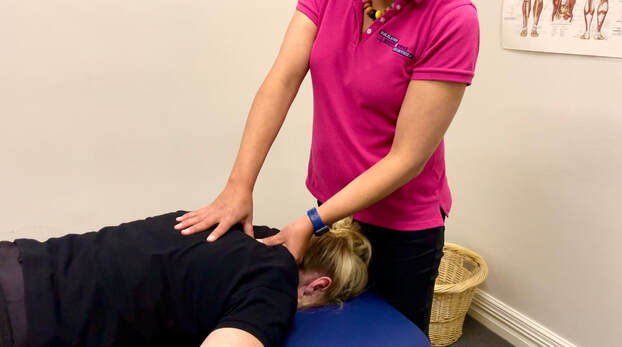|
Sometimes we worry about what’s wrong with our bodies, we feel a sharp pain, a tweak, or an ache in our back (or neck), then we panic, stop moving, and start googling. This can be unhelpful and it’s so hard to know what the right thing to do is… Do you need to go to Hospital, the Doctor, the Physio, Chiro, the massage guy, a specialist? Often, you’ve just over stretched or put yourself in a position that your body wasn’t happy to be in. These are the things I hear every day. “It’s out “ “It’s tight “ “It’s stiff” “I’m weak” “It’s damaged” The Dr said “It’s bone on bone” “Irreversible damage” “Old age” “Riddled with arthritis” We need to have something to blame for the pain. Combined with the stress and implications….. “I can’t sleep” “I can’t play sport “ “I can’t work” “I can’t travel” “I can’t play with my kids” “I’ll have pain for the rest of my life” These thoughts and stresses all contribute to your amount of pain and how long it will last for. Chances are it isn’t as bad as you thought initially. Unless you’ve done something crazy like fallen from a tree, crashed your car, been squashed in a footy scrum and even then, most people are fine (this obviously depends on how high up the tree you were). If we are talking backs, there are a few things that might help you to know:
So, what to do?
Sal’s 10 step plan: 1. Relative rest, (not bed rest) is best for a couple days, hot water bottles are lovely, regular anti-inflams/Panadol (if you can take these) - keep changing positions, try and keep any pain in your leg at a minimum, some gentle walking if you can, is also good idea. 2.You are generally better to lie down for a short rest than hang out on the lounge or recliner. Positions that lessen the leg pain are better. 3. Gently try and get moving. Back movements are good and won’t cause any damage. Lie on your tummy if you can and come up onto your elbows. Using a heat pack can help make this easier. Just lie there for 10 mins if you’re feeling ok. Up and down a few times over the time. Or try lying on your back and rolling your knees side to side. 4. Any position/stretch that lessons the leg pain or gets better after you do a few, then they are the ones to start with – little and often rather than a stack, then nothing. You can’t hurt yourself doing these. All the gentle movement is fabulous and helps to move any inflammation and swelling away. 5. Know that it will get better. 6. Pain is an interpretation of signals sent to our brains - messages are sent from the back to the brain. People in pain have their brain “lit up” on scanning. The inputs from the back is just one of these lights. There is a whole back pain network in your brain. Other things that contribute to “lighting up your brain” include other stresses, anxiety, depression and frustration. Things that improve or reduce this brain sensitivity are things that make you happy, calm, and less stressed. Change any of these more negative emotions to a positive one and aches and pains can reduce. Control what you can and let the rest go. 7. All pains and injuries involve the immune system. Pain can cause your immune system to become a bit out of balance. Anything that is good for the immune system will help your body cope with the pain. Immune healthy behaviors include working out ways to cope, graduated exercise, anti-inflammatory foods, laughter, sleep well, any interaction with nature, less alcohol (a glass of wine is ok, just not a bottle) and avoid drugs with opioids in them (these can make you more sensitive over time). 8. Challenge your perception about how bad it was initially 9. Seek the knowledge and treatment that will provide you with a well-rounded program including ways to reduce your pain, exercises, self-management strategies and advice to get you back doing the things you love, as soon as possible. The correct team of health professionals around you and supporting you is invaluable. (They will also help you with the correct plan of attack if things are not going to plan) . 10. Did I mention … Keep Moving? If this helps you or raises more questions, we are always here to answer questions and help you decide the correct treatment pathway. Look after yourself. Sally APA Musculoskeletal Physiotherapist Director, Tablelands Sports & Spinal Physiotherapy ☎️ 6352 3131 ✉️ [email protected] ℹ️ www.tablelandsphysio.com.au *** Please note this is generalised advice for people with back pain, not specific to your case. Please contact your local physio or healthcare professional if you are concerned about any of your symptoms or if they are increasing. The quicker you get on top of this the better. ***
0 Comments
|
Copyright © 2024 All Rights Reserved - TABLELANDS SPORTS & SPINAL PHYSIOTHERAPY
177 Mort Street Lithgow NSW 2790 : Tel: 02 6352 3131 : i[email protected]
Click here to view our Privacy Statement | Click here to take our Customer Satisfaction Survey | Click here to read our Complaints Procedure | Click here to view our Terms & Conditions
177 Mort Street Lithgow NSW 2790 : Tel: 02 6352 3131 : i[email protected]
Click here to view our Privacy Statement | Click here to take our Customer Satisfaction Survey | Click here to read our Complaints Procedure | Click here to view our Terms & Conditions

